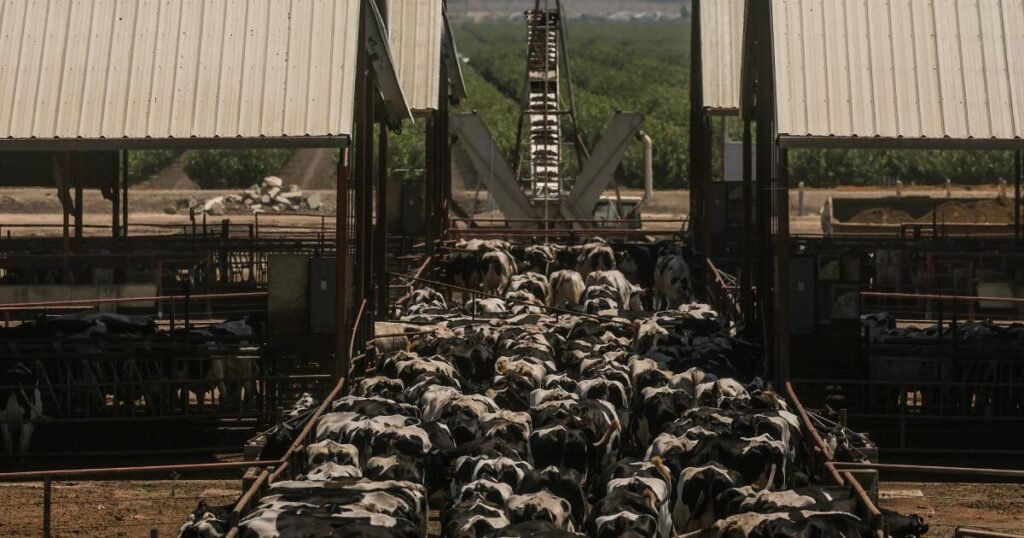California Leads in Cattle Feeding Operations
Researchers have pinpointed approximately 8,700 cattle feeding operations across the United States, revealing that California tops the list with the highest number. In fact, California hosts over 85,000 acres—equivalent to about 130 square miles—primarily dedicated to dairy cows. Tulare County stands out, housing more feedlots than any other county nationwide, with around 304 businesses. If it were a separate state, it would rank as the eighth largest in terms of cattle feeding operations, according to researchers from the University of Michigan and UC Santa Barbara.
Interestingly, until now, there hasn’t been a national database specifically for animal feed operations. The federal government hasn’t created one, and individual states often keep their data under wraps.
The data gathered aims to assist local governments and NGOs in developing targeted policies related to environmental, health, and economic concerns within their areas.
Andrew Decoriolis, director of Farm Forward, an organization focused on reducing industrial farming, commented, “It’s a really great study. This is the most comprehensive look I’ve seen, and the map effectively quantifies the number of operations.”
In addition to cattle, the research included mapping pig breeding. The U.S. ranks as the world’s second-largest livestock producer, only behind China, with a staggering 70% of cattle and 98% of pigs raised under similar feeding scenarios. Essentially, this involves packing a lot of animals into small spaces, feeding them high-energy diets until they are eventually used for milk and meat.
In California, dairy operations vary widely; some feature just a few hundred animals on the North Coast, while others exceed 10,000 in the San Joaquin Valley.
Such feeding strategies have been ongoing for decades and are often linked to degraded air and water quality. There tends to be sparse vegetation, and animals disturb the soil when they move around, kicking up dirt and dried fertilizer. Other research indicates that the workforce in this industry frequently faces challenges, with over half of the country’s dairy workers potentially being undocumented.
The absence of precise geographical data makes it tough for local governments and researchers to assess the impact of these facilities on community health and environmental conditions. So, the team developed a database that integrates existing datasets—national, regional, and even crowdsourced—cross-referenced with Google Earth imagery. After examining satellite images for over two years, they identified 15,726 cattle and pig feeding operations, collectively covering an area slightly larger than Rhode Island, amassing over 658,500 acres or 1,000 square miles.
This study was published in the journal Communications Earth & Environment. Joshua Newell, a geographer from the University of Michigan, emphasized that understanding how much land is used for these purposes is crucial. He noted that it affects nearby communities, including aspects like water pollution and health outcomes.
Interestingly, as researchers examined these feedlots, they observed a correlation between these operations and local air quality and economic indicators. The more extensive the land dedicated to cattle and pig farms in a specific area, the worse the social and economic conditions tend to be, as reflected in lower health insurance coverage rates in regions near these feeding operations.
However, Anjaraudabo, CEO of Western United Dairy, criticized the study for inaccuracies in its environmental and economic data. She pointed out that the researchers didn’t seem to consult the EPA or local regulatory bodies about existing air-quality measures.
She further noted that the air pollution challenges in San Joaquin Valley arise from a combination of factors, including busy highways like Interstate 5 and Highway 99, which contribute to trapping pollutants in the area.
In response, Newell mentioned that their analysis included comparisons of similar areas that were not adjacent to feeding operations, helping to explain the sources of contamination.
Recently, a federal court ruled that animal feeding operations are not required to report air emissions or hazardous pollutants to state and local authorities, which adds a layer of complexity to the issue.
Raudabaugh also voiced concerns regarding the claims made about environmental justice. She highlighted the nuances of rural healthcare challenges, especially during the pandemic. Rather than simplifying this to a matter of farming practices, she stated, “We need to enhance rural access to healthcare to meet the needs of our community.”







